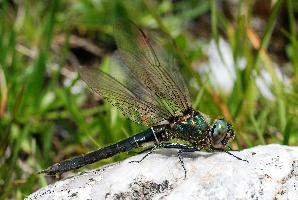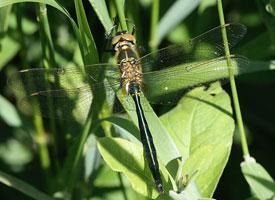
Poids et mesures
| Longueur | de 30 à 37 mm |
|---|---|
| Envergure des ailes | de 60 à 70 mm |
Description de l'animal
The Northern Emerald (Somatochlora arctica) is a captivating species of dragonfly belonging to the family Corduliidae, which encompasses a diverse group of medium to large-sized, metallic-hued dragonflies known for their energetic flight and often emerald eyes. This particular species is a testament to the beauty and intricacy of the natural world, displaying a unique combination of physical and behavioral traits that make it a subject of fascination among entomologists and nature enthusiasts alike.Physical Description:
The Northern Emerald is a striking creature, with adults typically reaching body lengths of about 45 to 55 mm. Its slender body is adorned with a metallic green sheen, which can appear almost golden under direct sunlight, making it a visually arresting sight in its natural habitat. The wings of the Northern Emerald are clear, with a span that allows for agile and swift flight. One of the most distinctive features of this species is its eyes, which are large and, true to its name, exhibit a deep emerald color. These eyes provide the dragonfly with excellent vision, aiding in the detection of prey and avoidance of predators.
Habitat and Distribution:
The Northern Emerald is found in a variety of freshwater habitats across the northern hemisphere, particularly favoring regions with cool temperatures. Its distribution spans across northern Europe, Asia, and North America, inhabiting boggy areas, forested wetlands, and slow-moving streams. These habitats offer the dense vegetation and abundant insect prey necessary for the Northern Emerald's survival.
Behavior and Ecology:
This dragonfly is known for its territorial behavior, especially among males, who vigilantly guard their chosen area from rivals. Males perform intricate flight patterns as part of their mating display to attract females. After mating, females lay their eggs in the vegetation of slow-moving or stagnant waters, where the larvae, also known as nymphs, will spend the initial phase of their life cycle. The larval stage is aquatic and can last for several years, during which the nymphs are voracious predators, feeding on a variety of aquatic organisms.
The diet of the Northern Emerald, both in its larval and adult stages, consists primarily of insects. Adults are adept hunters, catching their prey in mid-air with remarkable precision. Their diet plays a crucial role in controlling insect populations, highlighting the Northern Emerald's importance in its ecosystem.
Conservation Status:
The conservation status of the Northern Emerald varies by region, but habitat loss and degradation pose significant threats to its populations globally. Efforts to preserve the natural habitats of this species are crucial for its survival, emphasizing the need for continued research and conservation initiatives.
In conclusion, the Northern Emerald (Somatochlora arctica) is a remarkable dragonfly species, admired for its beauty and ecological role. Its presence enriches the biodiversity of its habitat, serving as both a predator and a spectacle of natural elegance. Protecting the environments that sustain the Northern Emerald is essential for ensuring that future generations can continue to marvel at this extraordinary insect.
Animaux similaires
Nouvelles photos d'animaux
Top 10 des animaux
- Dolphin gull (Leucophaeus scoresbii)
- Japanese macaque (Macaca fuscata)
- Greek tortoise (Testudo graeca)
- Stone loach (Barbatula barbatula)
- Galápagos tortoise (Geochelone nigra complex)
- Russian tortoise (Testudo horsfieldii)
- Diana monkey (Cercopithecus diana)
- Moustached guenon (Cercopithecus cephus)
- Common flying dragon (Draco volans)
- Galápagos penguin (Spheniscus mendiculus)


